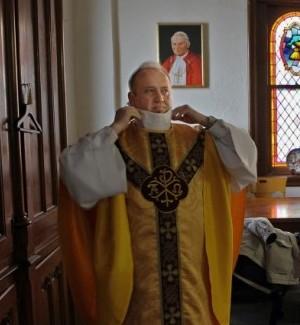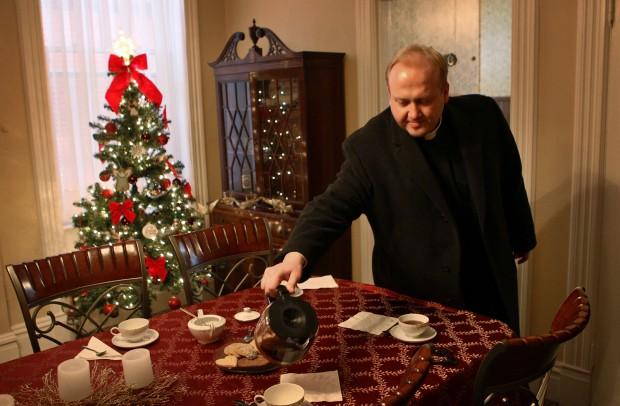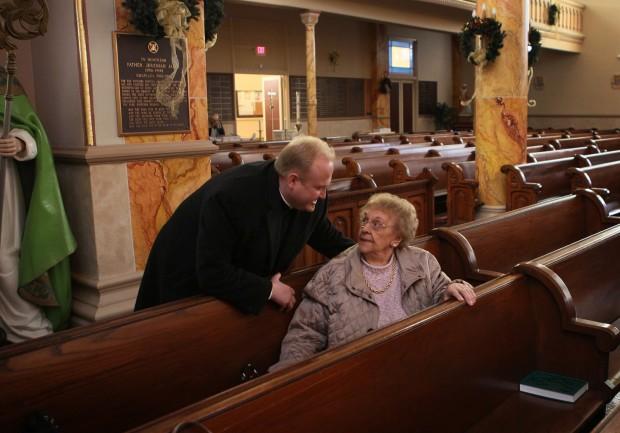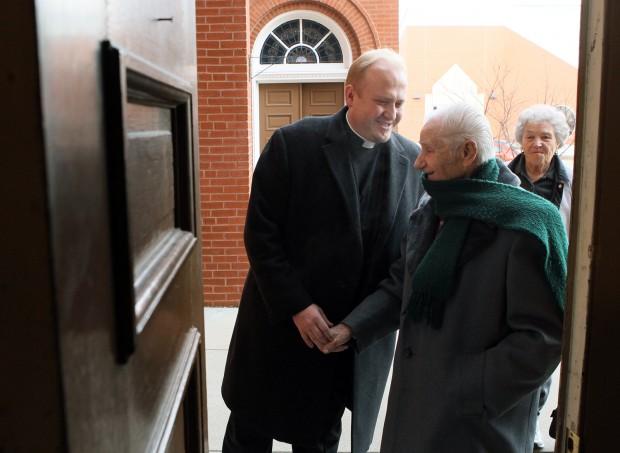By Tim Townsen
St. Louis Post-Dispatch
January 10, 2011
http://www.stltoday.com/lifestyles/faith-and-values/article_3d2a362b-4be6-5935-bd3d-4e4be4015458.html
 |
| 1/9/11 Sunday St. Louis Rev. Marek Bozek prepares for the first morning serice at St. Stanislaus Kostka Catholic Church Sunday in St. Louis. |
 |
| 1/9/11 Sunday St. Louis Rev. Marek Bozek pours coffee for visitors staying at the rectory at St. Stanislaus Kostka Catholic Church in St. Louis Sunday morning. |
 |
| 1/9/11 Sunday St. Louis Rev. Marek Bozek greets Jeanette Rudawski, from Town and Country, before the start of the service Sunday morning at St. Stanislaus Kostka Catholic Church in St. Louis. |
 |
| 1/9/11 Sunday St. Louis Rev. Marek Bozek, left, greets parishoner Stanley Kaminski Sunday morning at the door of St. Stanislaus Kostka Catholic Church in St. Louis. Behind them is another parishoner Shirley Kveton. |
A trial that could finally end the battle over the control of St. Stanislaus Kostka Catholic Church begins today in St. Louis Circuit Court.
It's been a long time coming.
Judge Bryan Hettenbach will revisit the emotions that have swirled around the St. Stanislaus story for six years, in what are expected to be three weeks of arguments.
He will hear about how members of the parish's lay board were separated from the Eucharist for eliminating the authority of the Roman Catholic Church hierarchy from their bylaws and entering into schism.
He will hear how, in 2005, a Polish priest from a neighboring diocese accepted an offer to pastor St. Stanislaus, without the approval of the Catholic Church, answering only to the lay board.
And he will hear how an archbishop brushed aside public relations considerations by publicly declaring multiple excommunications in defense of church doctrine and law.
Hettenbach also will hear more staid arguments about bylaws, articles of incorporation and nonprofit structure.
The trial will cover issues of authority and control, of what it means to be Catholic, and of tension between church hierarchy and the laity.
The case was instigated in 2008 when the Archdiocese of St. Louis sued to regain control of the church.
Bernard Huger, an attorney for the archdiocese, said the trial would be about "our request that (St. Stanislaus) be returned to the Roman Catholic Church." The actions of the parish's lay board "took away the necessary authority of the archbishop, and we're asking the court to restore that authority."
An attorney for St. Stanislaus said people have forgotten that his clients are the defendants.
"We did not bring this case," said George von Stamwitz. "It was brought by others to take control of the parish and its property. We don't believe the facts or the law justify that. … This is not a fight we wanted or asked for."
Link to 1891
While it took 18 months for the archdiocese's lawsuit to come to trial, the roots of the dispute can be traced back much further — more than a century.
In 1891, Archbishop Peter Kenrick agreed to allow the laity of the St. Louis Polish Catholic community to form a corporation that would govern the church's finances. Kenrick's move was not unusual at a time when immigrants often formed their own Catholic communities to buy land and build a church. By the 20th century, bishops had assumed control of most of those parishes around the country.
St. Stanislaus was a holdout
St. Louis archbishops through the decades made half-hearted attempts to get St. Stanislaus to fall in line, but it was the clergy sexual abuse scandal that erupted in Boston in 2002 that ultimately prompted the archdiocese to make a hard charge at regaining control.
In the wake of the abuse scandal, many dioceses around the country began changing their legal structures. The traditional "corporation sole" structure put all diocesan and parish assets in the bishop's name, which, in civil courts, made all of a diocese's funds liable in legal settlements.
In the corporation sole structure, parishes are considered unincorporated associations without identities separate from the diocese. By incorporating individual parishes, dioceses could protect their property and assets from lawsuits naming the bishop.
In June 2003, Archbishop Justin Rigali, now a cardinal and the archbishop of Philadelphia, announced a massive legal restructuring of the Archdiocese of St. Louis that would transform each parish from an unincorporated association to a nonprofit corporation. Rigali hoped St. Stanislaus, like every other parish, would go along with the changes, but parishioners were unwilling to give up the deal it made with Kenrick.
Rigali was transferred to Philadelphia soon after announcing the legal changes, and it fell to Archbishop Raymond Burke, Rigali's successor, to deal with St. Stanislaus.
In the church's original bylaws, its lay board controlled the property and assets while the archbishop appointed its board members and a pastor. But in 2001, and again in 2004, the church's board rewrote its bylaws, eventually eliminating the archbishop's authority, and setting up the St. Stanislaus Corp. as its legal entity.
Burke responded by pulling the church's priests, and eventually suppressing the church in 2005, leaving parishioners without a way to experience the Eucharist, one of the seven central liturgical rites of the church through which Catholics believe they experience God's grace.
Finding a priest
In 2005, the lay board named the Rev. Marek Bozek — then a priest in the Springfield-Cape Girardeau Diocese — as its pastor, something only bishops can do. Bozek was immediately suspended by his bishop, was later declared excommunicated by Burke and finally laicized by Pope Benedict XVI.
Bozek is no longer a Catholic priest, though he has said that he would someday like to be a bishop in an "underground Roman Catholic church." He has also said he intends to start a new church "that will be Catholic but not Roman Catholic — not Vatican Catholic — somewhere in St. Louis."
The bishops of the archdiocese also have declared at least 10 lay board members of the church excommunicated since 2005 for committing "the delict of schism," defined in church law as "the refusal of submission to the Roman Pontiff or of communion with the members of the Church subject to him." At least four have since reconciled with the church.
The Polish-born Bozek was hailed as a hero by St. Stanislaus members in 2005 for risking his vocation to lead a church some Catholics felt had been abandoned by the archdiocese. But over the last five years, Bozek's version of Catholicism drove away many of the church's traditional members. At the same time, his support for homosexuality in the church and women's ordination brought in a new group of parishioners.
In 2004, Burke told the Post-Dispatch that the St. Stanislaus corporation was set up by Kenrick to operate "as a Roman Catholic parish within the disciplines of the church."
He wrote that since the church was suppressed in 2005, "the St. Stanislaus Kostka Corporation has never been and is not now a part of the Roman Catholic Church but instead is a sect."
Carlson's offer
In 2008, the archdiocese and some former parishioners sued St. Stanislaus, asking Hettenbach to restore the church to the structure that existed before the bylaw changes. Benedict transferred Burke to Rome the same year, and Archbishop Robert Carlson took up the St. Stanislaus battle.
In July, Carlson made the congregation an offer.
"One of the concerns expressed again and again was that, even if an archbishop made a commitment to keep the parish operating so long as Roman Catholics of Polish heritage wanted to have a parish and were willing to support it, he could not bind his successors," Carlson wrote in a letter.
That concern led to a proposed solution involving two cooperating corporations — one looking out for the interests of the parish, the other representing the archdiocese. Though, in reality, because of the way the parish board would have been elected and approved, the archbishop would have controlled both corporations.
In August, 58 percent of the congregation voted to reject Carlson's offer, clearing the way for a trial date.
Burke, now a cardinal and head of the Vatican's highest court, was in St. Louis this weekend, celebrating Mass at the Cathedral Basilica. But Von Stamwitz, the attorney for St. Stanislaus, said he didn't think "any bishops or cardinals are going to testify live.
He said "lots of testimonies" would center on an episode in 2003, when Monsignor Richard Stika, now the bishop of Knoxville, Tenn., suggested to St. Stanislaus board members that if they did not capitulate to Rigali's demands to reform their legal structure, they would be excommunicated. The board members perceived Stika's actions as a threat and changed the parish bylaws for the final time.
Stika has said he was misunderstood and was simply trying to explain the concept of obedience.
Von Stamwitz called the episode "an ultimatum," and said "the law and facts surrounding it" would be "the crux" of the defense's case.
Contact: ttownsend@post-dispatch.com
Any original material on these pages is copyright © BishopAccountability.org 2004. Reproduce freely with attribution.